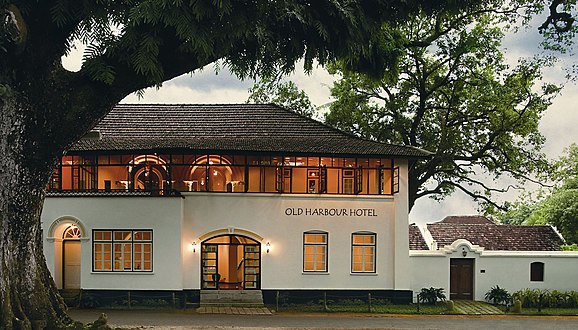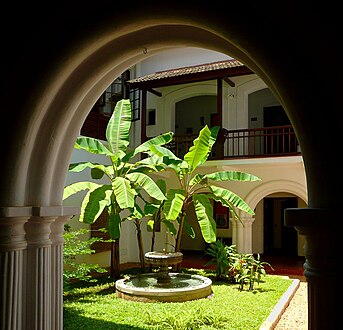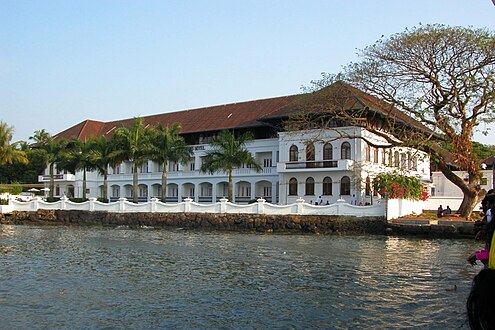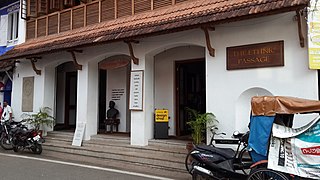
Ernakulam is one of the 14 districts in the Indian state of Kerala, and takes its name from the eponymous city division in Kochi. It is situated in the central part of the state, spans an area of about 2,924 square kilometres (1,129 sq mi), and is home to over 9% of Kerala's population. Its headquarters are located at Kakkanad. The district includes Kochi, also known as the commercial capital of Kerala, which is famous for its ancient churches, Hindu temples, synagogues and mosques.

Cochin Jews are the oldest group of Jews in India, with roots that are claimed to date back to the time of King Solomon. The Cochin Jews settled in the Kingdom of Cochin in South India, now part of the present-day state of Kerala. As early as the 12th century, mention is made of the Jews in southern India by Benjamin of Tudela.

Paradesi Jews refer to Jewish immigrants to the Indian subcontinent during the 15th and 16th centuries following the expulsion of Jews from Spain and Portugal. Paradesi means foreign in Malayalam and Tamil. These Sephardic immigrants fled persecution and death by burning in the wake of the 1492 Alhambra Decree and King Manuel's 1496 decree expelling Jews from Portugal. They are sometimes referred to as "White Jews", although that usage is generally considered pejorative or discriminatory and refers to relatively recent Jewish immigrants, predominantly Sephardim.

Justus Dahinden was a Swiss architect, teacher and writer about architecture.

The Paradesi Synagogue or the Mattancherry Synagogue is a synagogue located in Mattancherry Jew Town, a suburb of the city of Kochi, Kerala, in India. It was built in 1568 A.D. by Samuel Castiel, David Belila, and Joseph Levi for the flourishing Paradesi Jewish community in Kochi. Cochin Jews were composed mainly of the much older Malabari Jews and the newly arrived Sephardic refugees from the Portuguese religious persecution of Jews in Spain and Portugal. It is the oldest active synagogue in the Commonwealth of Nations. Paradesi is a word used in several Indian languages, and the literal meaning of the term is "foreigners", applied to the synagogue because it was built by Sephardic or Portuguese-speaking Jews, some of them from families exiled in Aleppo, Safed and other West Asian localities.
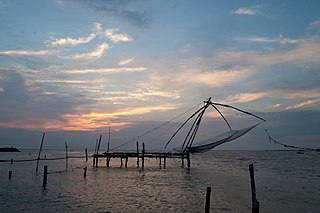
Fort Kochi, formerly known as Fort Cochin or British Cochin, is a neighbourhood of Kochi city in Kerala, India. Fort Kochi takes its name from the Fort Manuel of Kochi, the first European fort on Indian soil, controlled by the Portuguese East Indies. This is part of a handful of water-bound islands and islets toward the south-west of the mainland Kochi, and collectively known as Old Kochi or West Kochi. Adjacent to this is the locality of Mattancherry. In 1967, these three municipalities along with a few adjoining areas, were amalgamated to form the Kochi Municipal Corporation.
Abraham ben Barak Salem was an Indian nationalist and Zionist, a lawyer and politician, and one of the most prominent Cochin Jews of the twentieth century. Popularly known by his epithet of "Jewish Gandhi", he was known as "Salem Kocha" to the resident Jewish community of Cochin. A descendant of Meshuchrarim, he was the first Cochin Jew to become an attorney. He practised in Ernakulam, where he eventually used Satyagraha to fight the discrimination among Paradesi Jews against Malabari Jews. An activist in the trade union and Indian national causes, he later was attracted to Zionism. After visiting Palestine in the 1930s, he later helped arrange the migration of most Cochin Jews to Israel by 1955. He stayed in Kochi for the remainder of his life.

The Mala Synagogue is one of the oldest extant synagogues in India and was built by the historic Malabar Jews of Kerala. It is located at Mala, a small town in Thrissur district of Kerala state in south India.

Carl Moritz was a German architect and real-estate entrepreneur. Based in Cologne, he built the Cologne Opera House of 1902, and various banks, theatres and churches in Germany. Some of his buildings were destroyed during the last two years of his life in World War II.

The Kochangadi Synagogue, or Misro Synagogue was a historic synagogue located in Kochangadi, south of Jew Town in Kochi, in the coastal state of Kerala. It was built in 1344 A.D by the Malabari Jews after fleeing from Cranganore, making it the oldest synagogue in India in recorded history. It was lost and never rebuilt. The subsequent Kadavumbhagam Synagogue and Thekkumbhagam Synagogue were built after this congregation was established. The name "Kochangadi" is an abbreviation of "Kocha Angadi" or "Jew Market", as jews were addressed as Kocha in colloquial Malayalam.

Josef Kaiser was an East German urban architect associated, in particular, with a number of the country's more high-profile building projects during the 1950s and 1960s. In 1946, following serious illness, he embarked on a career as an operatic tenor: five years later he returned to architecture.

Christoph Sattler is a prolific German architect who has been professionally active since the early 1970s. Most of his more prominent buildings are in southern Germany or Berlin. Although he is known for a number of large high-profile residential developments, he has also attracted widespread critical and public attention with public buildings and structures such as the Seeparkturm in Freiburg, the Kupferstichkabinett in Berlin, various underground stations such as those of Am Hart (Munich) and Mendelssohn-Bartholdy-Park (Berlin) and several art galleries including the controversial Gemäldegalerie in Berlin. He studied for several years during the 1960s in North America as a post-graduate student. During that period he was employed with the firm of Ludwig Mies van der Rohe.
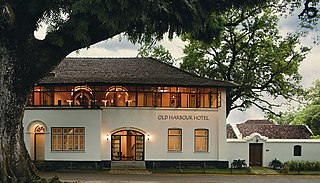
Old Harbour House is a building in the center of Fort Kochi, part of the city of Kochi in the district of Ernakulam in the state of Kerala (India). It was built during the Portuguese colonial period, almost completely rebuilt by the Dutch in the 17th century, and later modified by the British. In 2006, it was carefully restored by German architect Karl Damschen with many references to its colonial origins. Today the building contains the boutique hotel Old Harbour Hotel.
The Thekkumbhagam MattancherrySynagogue aka Thekkumbhagam Synagogue was a synagogue located in Mattancherry Jew Town, a suburb of Kochi, Kerala, in South India. It was built in 1647 AD. by the Malabar Jews, on land donated by the Maharajah of Cochin and was one of the oldest known synagogues in India. It was the fourth to be built in Mattancherry after they fled to Cochin from Muziris and it was one of three in the area, the others being the Kadavumbhagam Mattancherry Synagogue and the Paradesi Synagogue of the Paradesi Jews of Cochin.

Kadavumbhagam Mattancherry Synagogue aka Kadavumbhagam Synagogue is a Jewish synagogue located in Mattancherry, a locality in Kochi, in the coastal state of Kerala. It is one of the oldest extant synagogues in India, built in 1544 A.D. It was built by the Malabar Jews who are the oldest jewish settlers in India, believed to have arrived as traders in the ancient port city of Muziris. It was the second to be built in Mattancherry, after the Kochangadi Palli in 1344 A. D., and is one of three synagogues in the area. The others being the Thekkumbhagam Mattancherry Synagogue (extinct) and the Paradesi Synagogue of the Paradesi jews of Cochin.

The Kadavumbhagham Ernakulam Synagogue in Kerala, India, is the restored oldest synagogue of the Malabar Jews with a Sefer Torah scroll and offering occasional services. It was established in 1200 CE and restored several times through the centuries on the same site. It is modeled on the earliest synagogue of the Malabar Jews at Muziris, which dated from the time of ancient sea trade between the Mediterranean and Kerala.




